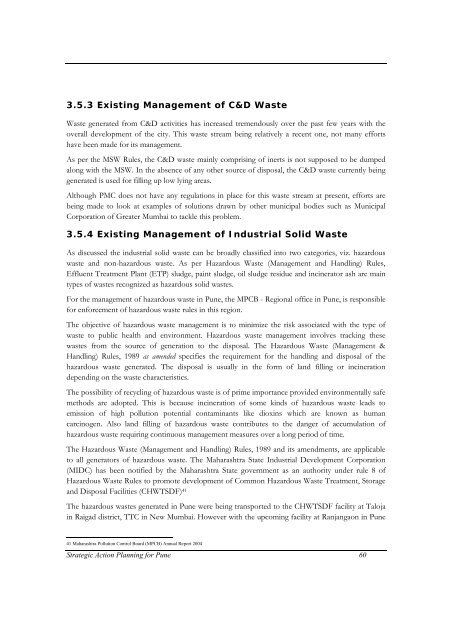Strategic Action Plan - International Environmental Technology Centre
Strategic Action Plan - International Environmental Technology Centre
Strategic Action Plan - International Environmental Technology Centre
You also want an ePaper? Increase the reach of your titles
YUMPU automatically turns print PDFs into web optimized ePapers that Google loves.
3.5.3 Existing Management of C&D Waste<br />
Waste generated from C&D activities has increased tremendously over the past few years with the<br />
overall development of the city. This waste stream being relatively a recent one, not many efforts<br />
have been made for its management.<br />
As per the MSW Rules, the C&D waste mainly comprising of inerts is not supposed to be dumped<br />
along with the MSW. In the absence of any other source of disposal, the C&D waste currently being<br />
generated is used for filling up low lying areas.<br />
Although PMC does not have any regulations in place for this waste stream at present, efforts are<br />
being made to look at examples of solutions drawn by other municipal bodies such as Municipal<br />
Corporation of Greater Mumbai to tackle this problem.<br />
3.5.4 Existing Management of Industrial Solid Waste<br />
As discussed the industrial solid waste can be broadly classified into two categories, viz. hazardous<br />
waste and non-hazardous waste. As per Hazardous Waste (Management and Handling) Rules,<br />
Effluent Treatment <strong>Plan</strong>t (ETP) sludge, paint sludge, oil sludge residue and incinerator ash are main<br />
types of wastes recognized as hazardous solid wastes.<br />
For the management of hazardous waste in Pune, the MPCB - Regional office in Pune, is responsible<br />
for enforcement of hazardous waste rules in this region.<br />
The objective of hazardous waste management is to minimize the risk associated with the type of<br />
waste to public health and environment. Hazardous waste management involves tracking these<br />
wastes from the source of generation to the disposal. The Hazardous Waste (Management &<br />
Handling) Rules, 1989 as amended specifies the requirement for the handling and disposal of the<br />
hazardous waste generated. The disposal is usually in the form of land filling or incineration<br />
depending on the waste characteristics.<br />
The possibility of recycling of hazardous waste is of prime importance provided environmentally safe<br />
methods are adopted. This is because incineration of some kinds of hazardous waste leads to<br />
emission of high pollution potential contaminants like dioxins which are known as human<br />
carcinogen. Also land filling of hazardous waste contributes to the danger of accumulation of<br />
hazardous waste requiring continuous management measures over a long period of time.<br />
The Hazardous Waste (Management and Handling) Rules, 1989 and its amendments, are applicable<br />
to all generators of hazardous waste. The Maharashtra State Industrial Development Corporation<br />
(MIDC) has been notified by the Maharashtra State government as an authority under rule 8 of<br />
Hazardous Waste Rules to promote development of Common Hazardous Waste Treatment, Storage<br />
and Disposal Facilities (CHWTSDF) 41<br />
The hazardous wastes generated in Pune were being transported to the CHWTSDF facility at Taloja<br />
in Raigad district, TTC in New Mumbai. However with the upcoming facility at Ranjangaon in Pune<br />
41 Maharashtra Pollution Control Board (MPCB) Annual Report 2004<br />
<strong>Strategic</strong> <strong>Action</strong> <strong>Plan</strong>ning for Pune 60
















